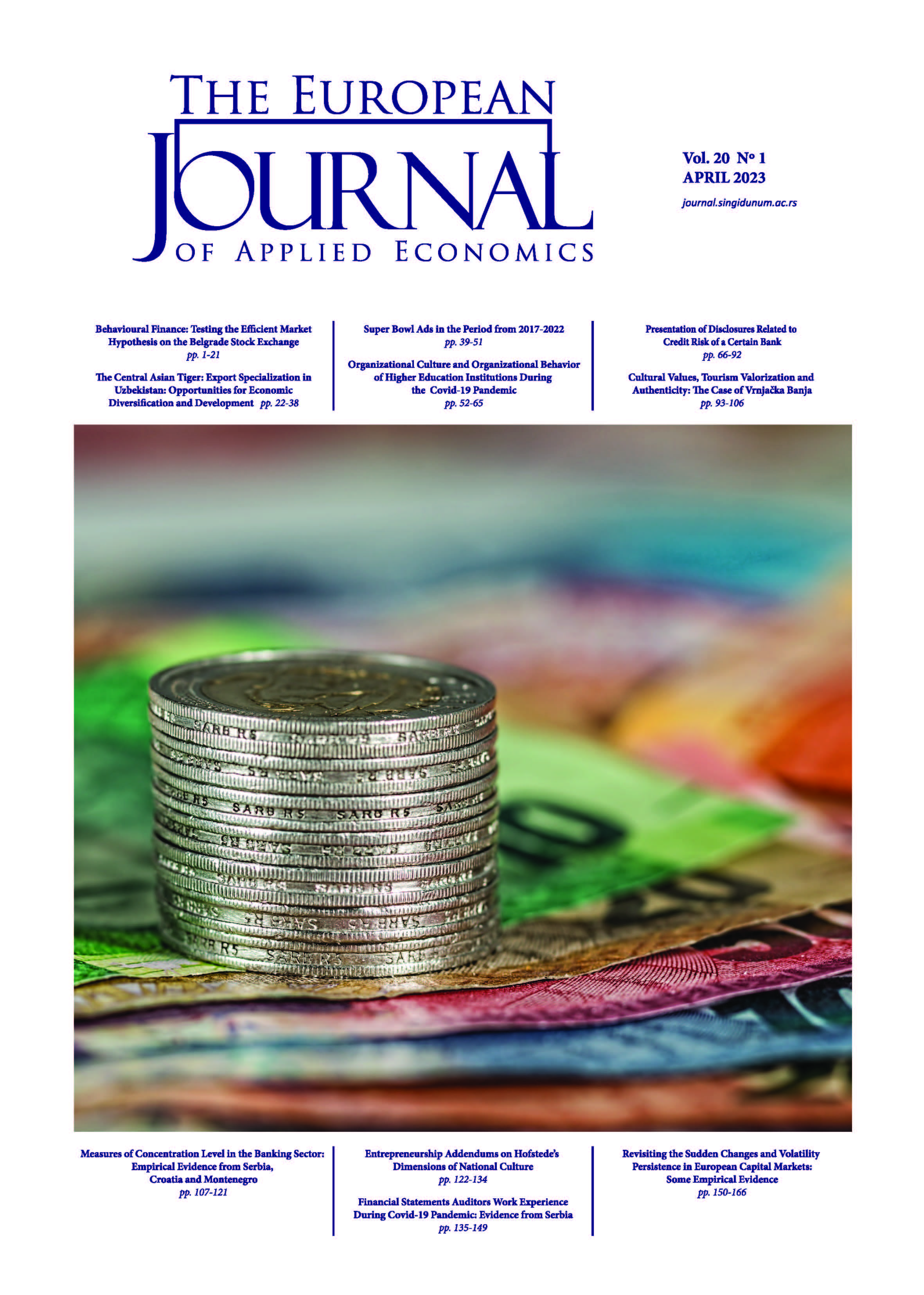THE CENTRAL ASIAN TIGER: EXPORT SPECIALIZATION IN UZBEKISTAN: OPPORTUNITIES FOR ECONOMIC DIVERSIFICATION AND DEVELOPMENT
Abstract
As expansion along the Silk Road is flourishing this research examines export specialization in Uzbekistan through a time series analysis of RCA and RSCA with a discussion on how export diversification has led to economic development since 2017. International trade in Uzbekistan and the region of Central Asia is first explored through history before the most recent data is examined. Specialized sectors (silk, cotton, edible fruits and vegetables, copper, etc.) are explored through the analysis, policy initiatives, and extant literature within a comprehensive discussion. Finally, policy recommendations are provided. This research is the first to explore export specialization in Uzbekistan through RCA and RSCA. It highlights the efforts of the current Uzbek administration to diversify and develop its economy by harnessing the power of international trade. Other Central Asian and developing economies could learn from this case.
References
Act Number PP-230. (2019). https://cis-legislation.com/document.fwx?rgn=115107.
Act Number PP-2687. (2016). https://cis-legislation.com/document.fwx?rgn=92343.
Act Number PP-3768. (2018). https://cis-legislation.com/document.fwx?rgn=107391.
Act Number PP-3910. (2018). https://cis-legislation.com/document.fwx?rgn=127995.
Act Number UP-5276. (2017). https://cis-legislation.com/document.fwx?rgn=103493.
Act Number PP-5853. (2019). https://cis-legislation.com/document.fwx?rgn=120078.
Act Number PP-778. (2017). https://cis-legislation.com/document.fwx?rgn=101292.
Abdullaev A. F., and M. M. Ikramov. (2019). Trends of development of the economy of the Republic of Uzbekistan. International Journal of Humanities and Natural Sciences 1-2: 48–50.
Axmedov, N. (2014). Ipak Qurti Ekologiyasi Va Boqish Agrotexnikasi, Cho'lpon nomidagi. Tashkent: NMIU.
Balassa, B. (1965). Trade liberalization and ‘revealed’ comparative advantage.” The Manchester School of Economic and Social Studies 32: 99–123.
Cotton Textile Cluster Association. (2022). www.uzts.uz/hlopkovo-tekst klaster/.
Gaibnazarova, Z. T., and S. A. Isamuxammedov. (2020). Iqtisodiyot Nazariyasi. Tashkent: Innovatsion Rivojlanish Publishing House.
Gazeta UZ. (2019). Export is not a will but an obligation. www.gazeta.uz/ru/2019/08/13/export/
Heckscher, E. F., and B. Ohlin. (1991). Heckscher-Ohlin Trade Theory, translated, edited, and introduced by Harry Flam and M. June Flanders. Cambridge, MA: MIT Press.
Hinloopen, J., and C. van Marrewijk. (2008). Empirical relevance of the Hillman condition for revealed comparative advantage: 10 stylized facts. Applied Economics 40: 2313–2328.
Khodiev, B. Y., and S. S. Shodmonov. (2017). Iqtisodiyot nazariyasi. Barkamol Faiz Media Publishing House, Tashkent, Uzbekistan.
Laursen, K. 2015. Revealed comparative advantage and the alternatives as measures of international specialization. Eurasian Business Review 5(1): 99–115.
National Statistics of Uzbekistan. (2021). www.stat.uz.
Newton, F. (1976). Soviet Central Asia: Economic Progress and Problems. Middle Eastern Studies 12(3): 97–104.
Nodirkhanov, U. (2020). Export development of the Republic of Uzbekistan. Market, Money and Credit 277(6): 41–49.
Normatov, J. (2018). Uzbekistan’s long way to the World Trade Organization (WTO). Centre International de Formation Européenne 385(1): 104–111.
OECD. (2011). Globalization, Comparative Advantage and the Changing Dynamics of Trade. Paris: OECD.
Pitoňáková, R. 2020. Measuring trade specialization of Slovakia on extra EU market. International Journal of Trade and Global Markets 13(1): 3–10.
Porter, M. E. (1980). Competitive Strategy: Techniques for Analyzing Industries and Competitors. New York: Free Press.
Review UZ. (2021). Uzbekistan is named the new “Asian tiger”. https://review.uz/en/post/uzbekistan-nazvan-novm-aziatskim-tigrom.
Ricardo, D. (1817). On the Principles of Political Economy and Taxation. London: John Murray.
Rosenberg, C. B., and M. D. Zeeuw. (2000). Welfare Effects of Uzbekistan’s Foreign Exchange Regime. IMF Working Paper 00/61. https://www.elibrary.imf.org/downloadpdf/journals/001/2000/061/article-A000-en.xml.
Scarborough, I. (2021). Central Asia in the Soviet Command Economy. Oxford Research Encyclopedias: Asian History. https://doi.org/10.1093/acrefore/9780190277727.013.504.
Smith, A. (1776). An inquiry into the nature and causes of the wealth of nations. London: Strahan and Cadell.
Stephens, A. R., and R. Kasamanli. (2020). An analysis of North Korean trade amid warming global relations utilizing RCA, RSCA, and TBI. The European Journal of Applied Economics 17(1): 113–127. doi:10.5937/EJAE17-24702.
Stephens, A. R. and Y. S. Gyun. (2018). An exploratory study on the expansion of the African market by global firms focusing on Liberia utilizing the Balassa Index. The e-Business Studies 19(6): 177–198.
Taseer, A. (2020). In Uzbekistan, Coming to Terms with the Country’s Dazzling History. New York Times. https://www.nytimes.com/2020/05/11/t-magazine/uzbekistan-history-silk-road.html.
UNCTAD (2014) Investment Guide to the Silk Road, United Nations Conference on Trade and Development. https://unctad.org/webflyer/investment-guide-silk-road.
UNCTAD (2021) Uzbek dry food exports: Prospects, Problems and Potential, United Nations Conference on Trade and Development. https://unctad.org/webflyer/uzbek-dry-fruit-exports-prospects-problems-and-potential.
UNIDO (1986) International comparative advantage in manufacturing: Changing profiles of resources and Trade. UNIDO Publication Sales No. E86 II B9. United Nations Industrial Development Organization, Vienna. https://digitallibrary.un.org/record/41218?ln=en.
UZ Daily. (2017). Production of jewelry without license is illegal from 1 October 2017. uzdaily.uz/en/post/40428.
Vollrath, T. H. (1991). A theoretical evaluation of alternative trade intensity measures of revealed comparative advantage.” Weltwirtschaftliches Archiv. 127: 265–280.
Yeats, A. J. (1985). On the appropriate interpretation of the revealed comparative advantage index: implications of a methodology based on industry sector analysts.” Weltwirtschaftilches Archiv. 121: 61–73.
Yoldashev, A. (2021). Samarqandda gilam va gilam mahsulotlari ishlab chiqarish imkoniyatlari qanday? Xalq so’zi. www.xs.uz/uz/post/samarqandda-gilam-va-gilam-mahsulotlari-ishlab-chiqarish-imkoniyatlari-qandaj.
Yuldashev, S. G., N. K. Zokirova, and M. Y. Khodjaeva. (2016). Uzbek model as a factor in the development of the national economy. Russian Economic University in Tashkent 12: 22 - 39.


